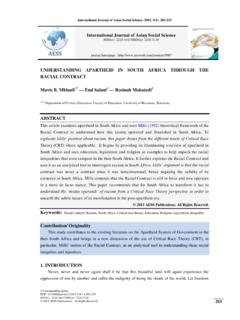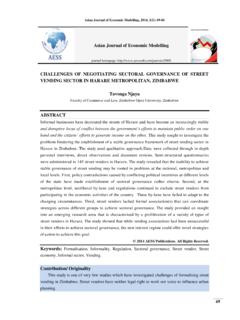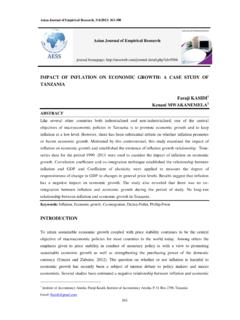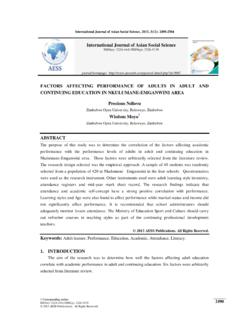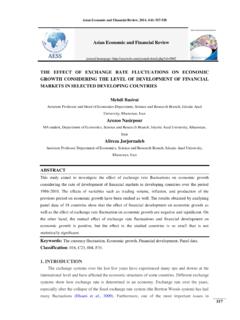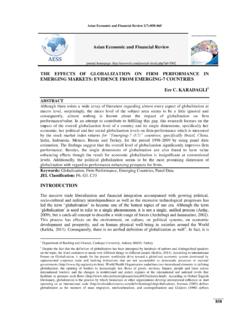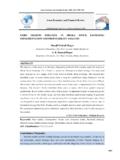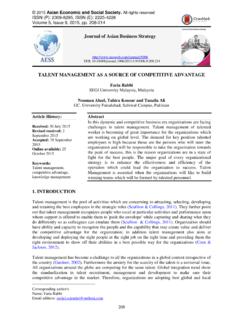Transcription of ABSTRACT - aessweb.com
1 Asian Economic and Financial Review, 2013, 3(4):483-489 483 THE COMPOSITION AND REGULATION OF THE FINANCIAL SERVICES SECTOR IN ZIMBABWE Miriam Zhanero Mugwati Midlands State University, Faculty of Commerce, Department of Marketing Management Doreen Nkala Midlands State University, Faculty of Commerce, Department of Marketing Management Costain Mukanganiki Midlands State University, Graduate School of Business Leadership ABSTRACT Zimbabwe s financial services sector continues to be found falling short in terms of observing corporate governance principles. The majority of the problems racking the sector are due to the existence of a number of regulatory bodies regulating the components that make it up.
2 The country is currently in the process of crafting its National Code of Corporate Governance, and unless what constitutes the financial services sector in Zimbabwe is clearly defined, specific requirements for governance in the sector likely to be contained within the Code may fail to bring sanity to it. It is in this vein that the paper seeks to define what constitutes the financial services sector in Zimbabwe. The paper outlines the composition of the financial services sector in Zimbabwe by taking a comparative approach in the scope of these institutions from a regional and international dimension vis-a-vis its dynamism. The authors adopt the documentary review research method to define the composition of the financial services sector in Zimbabwe.
3 The paper demonstrates that Zimbabwe s financial services sector comprises of financial banking and non-financial banking institutions . The type of institutions that fall under these two major categories does not differ from what constitutes the financial services sector in other countries but what differs is the way the sector is regulated and supervised thus making Zimbabwe s financial services sector sophisticated. Keywords: Financial Services Sector, Regulation, Composition Paper Type: Discussion paper Asian Economic and Financial Review journal homepage: Asian Economic and Financial Review, 2013, 3(4):483-489 484 INTRODUCTION World wide experience confirms that the countries with well-developed and market-oriented financial systems have grown faster and more steadily than those with weaker and closely regulated systems (World Economic Outlook, 2006; Subramanian and Williamson, 2009).
4 The financial sector in general and banking system, in particular, in many of the developing countries have been plagued by various systemic problems which necessitated drastic structural changes as also a re-orientation of approach in order to develop a more efficient and well functioning financial system (Sarkar, 2010). Zimbabwe has not been spared these problems that have bedeviled the financial institutions the world over. The situation has also been worsened by developments in technology which have brought in new products and players into the sector. For example, mobile banking has resulted in strategic alliances between banking institutions and network service providers thus making network service providers players within the sector.
5 As a result of these new players joining the sector, (Falkena et al., 2001) argue that A major issue in regulation, especially as financial institutions become more complex and diversified, relates to the structure of regulatory bodies and, in particular, whether regulation and supervision should be conducted on the basis of multiplicity of specialist agencies or by a single regulatory authority, . This discussion paper has therefore, made an attempt to come up with a clear scope of what constitutes the financial services sector in Zimbabwe taking into account the current state and what may also be perceived to be what the country is aspiring, suggesting that issues of corporate governance in Zimbabwe may take a unique form.
6 There seems to be no universally accepted definition which accurately defines the financial services sector. The definitions seem to differ according to one s perspective or place within the sector. To arrive at a suggested definition which suits the Zimbabwean context there is great need to review international and regional countries dimensions. The countries have been randomly selected taking note of those countries which have codes on corporate governance in the region as well as internationally whose economies are seen to perform better as a result of good corporate governance practices. Godspeed (2011) is of the opinion that defining financial services as any services that has a financial association would be too wide to be meaningful.
7 He therefore defines the South African financial services sector as comprising banks, insurers, fund managers, the Johannesburg Stock Exchange, microfinance companies and pension funds The sector is backed by a sound regulatory and legal framework. In South Africa the sector has been segmented into two categories, in line with the regulatory system which governs the institutions . The Financial Services Board oversees the regulation of financial institutions , including insurers, fund managers, and broking operations Asian Economic and Financial Review, 2013, 3(4):483-489 485 but excluding banks, which fall under the South African Reserve Bank. It is important to note that South Africa has a robust, well regulated market due to the country s central bank maintaining its independence from government (Mayer and Onyango, 2005) (Department of Trade and Industry Report, 2010).
8 South Africa s financial regulatory system has undergone enormous changes including the transfer of responsibility for banking supervision from the Department of finance (now known as the National Treasury) to the South African Reserve Bank in 1987, the establishment of the Financial Services Board in 1989 and the creation of the Policy Board for Financial Services and Regulatory by Act of Parliament in 1993 (Falkena et al., 2001). The National Payment System Act of 1998 for South Africa was introduced to bring the South African financial settlement system in line with international practice on settlement systems and systematic risk management procedures. The Act provides greater powers to the South African Reserve Bank, in respect of providing clearing and settlement facilities.
9 The Financial Services Board is a unique independent institution which is a creation of statute and it oversees South Africa s non-banking financial services industry in the public interest. Major financial institutions regulated by the board include the country s exchanges and insurers, both short term and long term (Falkena et al., 2001). The South African perspective thus reflects that the financial services sector is comprised of banking institutions which include commercial, mortgage finance , building societies and merchant banking as constituting the most famous in the area and these have a different regulatory structure altogether (Ferhani and Sayeh, 2008). The sector includes other businesses with a financial association such as insurance companies, stock exchange market, equity fund managers and investment houses (Gordhan, 2011).
10 It is not very clear whether the real estate group should also be included here since they also hold trust funds for their clients. Under the non-banking institutions are micro finance or money lending companies and according to (Meagher, 2002) these are regulated by South Africa s micro finance Regulatory Council. (The United Kingdom Foresight Financial Services Report, 2010) acknowledges that they could not find a universally accepted definition of the financial services sector. The report does not therefore adopt a rigid or precise definition of financial services and places its prime emphasis on banking, insurance and financial markets rather on areas such as law and accountancy.

